Marengo, Iowa
Marengo is a town in and the county seat of Iowa County, Iowa, United States.[4] It has served as the county seat since August 1845, even though it was not incorporated until July 1859.[5] The population was 2,528 in the 2010 census, a decline from 2,535 in 2000.[6][7]
Marengo, Iowa | |
|---|---|
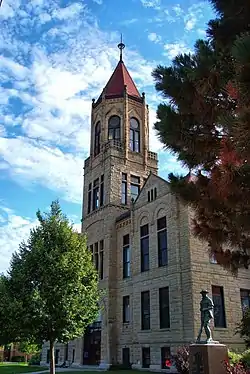 Iowa County Courthouse | |
| Motto(s): "Our town make it yours" | |
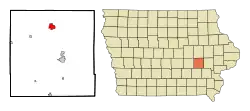 Location of Marengo, Iowa | |
| Coordinates: 41°47′50″N 92°4′10″W | |
| Country | |
| State | |
| County | Iowa |
| Area | |
| • Total | 2.18 sq mi (5.64 km2) |
| • Land | 2.12 sq mi (5.48 km2) |
| • Water | 0.06 sq mi (0.16 km2) |
| Elevation | 738 ft (225 m) |
| Population | |
| • Total | 2,528 |
| • Estimate (2019)[3] | 2,466 |
| • Density | 1,165.96/sq mi (450.20/km2) |
| Time zone | UTC-6 (Central (CST)) |
| • Summer (DST) | UTC-5 (CDT) |
| ZIP code | 52301 |
| Area code(s) | 319 Exchange: 642 |
| FIPS code | 19-49395 |
| GNIS feature ID | 0458801 |
| Website | City website |
History
Marengo was laid out in 1845 and platted in 1847.[8] The city's name commemorates the Battle of Marengo, where Napoleon defeated the Austrian army.[9]
The Iowa County Courthouse, built in 1893, is on the National Register of Historic Places.
Geography
According to the United States Census Bureau, the city has a total area of 2.14 square miles (5.54 km2), of which 2.08 square miles (5.39 km2) is land and 0.06 square miles (0.16 km2) is water.[10]
The Iowa River passes north of town.
Demographics
| Historical population | |||
|---|---|---|---|
| Census | Pop. | %± | |
| 1850 | 50 | — | |
| 1870 | 1,693 | — | |
| 1880 | 1,738 | 2.7% | |
| 1890 | 1,710 | −1.6% | |
| 1900 | 2,007 | 17.4% | |
| 1910 | 1,786 | −11.0% | |
| 1920 | 2,048 | 14.7% | |
| 1930 | 2,112 | 3.1% | |
| 1940 | 2,260 | 7.0% | |
| 1950 | 2,151 | −4.8% | |
| 1960 | 2,264 | 5.3% | |
| 1970 | 2,235 | −1.3% | |
| 1980 | 2,308 | 3.3% | |
| 1990 | 2,270 | −1.6% | |
| 2000 | 2,535 | 11.7% | |
| 2010 | 2,528 | −0.3% | |
| 2019 (est.) | 2,466 | [3] | −2.5% |
| U.S. Decennial Census[11] | |||
2010 census
As of the census[2] of 2010, there were 2,528 people, 1,059 households, and 648 families living in the city. The population density was 1,215.4 inhabitants per square mile (469.3/km2). There were 1,154 housing units at an average density of 554.8 per square mile (214.2/km2). The racial makeup of the city was 97.3% White, 0.6% African American, 0.6% Native American, 0.4% Asian, 0.4% from other races, and 0.7% from two or more races. Hispanic or Latino of any race were 2.8% of the population.
There were 1,059 households, of which 30.5% had children under the age of 18 living with them, 45.2% were married couples living together, 10.3% had a female householder with no husband present, 5.7% had a male householder with no wife present, and 38.8% were non-families. 34.4% of all households were made up of individuals, and 17.2% had someone living alone who was 65 years of age or older. The average household size was 2.31 and the average family size was 2.94.
The median age in the city was 41 years. 24.9% of residents were under the age of 18; 6.9% were between the ages of 18 and 24; 24% were from 25 to 44; 26.2% were from 45 to 64; and 18.1% were 65 years of age or older. The gender makeup of the city was 47.9% male and 52.1% female.
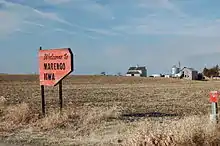
2000 census
As of the census[12] of 2000, there were 2,535 people, 1,057 households, and 658 families living in the city. The population density was 1,210.5 people per square mile (468.3/km2). There were 1,135 housing units at an average density of 542.0 per square mile (209.7/km2). The racial makeup of the city was 98.11% White, 0.28% African American, 0.04% Native American, 0.67% Asian, 0.28% from other races, and 0.63% from two or more races. Hispanic or Latino of any race were 1.14% of the population.
There were 1,057 households, out of which 30.4% had children under the age of 18 living with them, 48.9% were married couples living together, 9.5% had a female householder with no husband present, and 37.7% were non-families. 32.9% of all households were made up of individuals, and 16.5% had someone living alone who was 65 years of age or older. The average household size was 2.32 and the average family size was 2.98.
Age spread: 25.4% under the age of 18, 6.9% from 18 to 24, 27.5% from 25 to 44, 21.5% from 45 to 64, and 18.7% who were 65 years of age or older. The median age was 38 years. For every 100 females, there were 88.9 males. For every 100 females age 18 and over, there were 85.5 males.
The median income for a household in the city was $36,509, and the median income for a family was $47,153. Males had a median income of $32,986 versus $21,401 for females. The per capita income for the city was $17,425. About 6.1% of families and 7.3% of the population were below the poverty line, including 6.5% of those under age 18 and 11.9% of those age 65 or over.
Arts and culture
Library
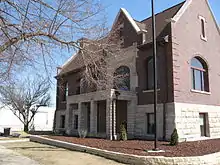
The Marengo Public Library is a Carnegie library, constructed in 1904–1905. Marengo is believed to be the smallest town in the United States to have received a donation from Andrew Carnegie for the construction of a library. The Library completed a renovation and addition in May 2007.[13]
Pioneer Heritage Museum
The Iowa County Historical Society operates the Pioneer Heritage Museum, located at 675 East South St., Marengo. The museum houses two log cabins and a farmhouse, relocated from other sites in the area; and displays of farm implements, household artifacts, clothing and military history items from local residents.
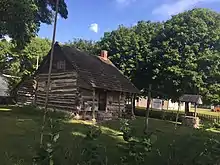
There is also a Chicago Rock Island RR depot relocated from Victor, Iowa and a 1930s filling station relocated from Hartwick, Iowa.[14]
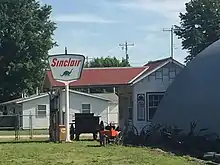
Rolle Bolle Courts
Marengo's Rolle Bolle courts are located at the intersection of Marengo Avenue and E May Street, Marengo.
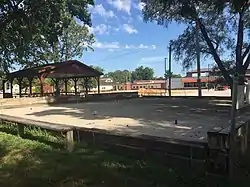
The traditional yard game (known as krulbollen in Belgium) was first brought to the area by Belgian immigrants in the late 19th and early 20th centuries.[15] Today, it is played by many local residents as well as by people in the neighboring towns of Victor, Clutier, Belle Plaine, Ladora, and Blairstown.
Education
Local public schools in Marengo include Iowa Valley Elementary School and Iowa Valley Junior Senior High School, part of the Iowa Valley Community School District. The Iowa Valley Junior High and High School teams are the Tigers.
The Iowa Valley Tigers were the dominant 1985 State Champions in Track and Field for Class 2A, winning 45 points over the second place team's 31.50.[16] This included Matt Zuber's Class 2A records in the long jump (24'-3") and the 110 meter high hurdles (14.1 sec).[17]
Notable people
- Cliff Clevenger was a U.S. Representative from Ohio who had a business in Marengo
- Travis Fiser, American high school wrestling coach, former collegiate wrestler, and a member of the National Wrestling Hall of Fame.
- Cindy Gerard, award-winning romance author, currently lives outside Marengo.[18]
- Paul Hinrichs, born in Marengo, was a relief pitcher in Major League Baseball,
- Bradley Kasal, born in Marengo, is a Sergeant Major in the U.S. Marine Corps and recipient of the Navy Cross
- Del Miller, born in Marengo, is a college football coach, formerly head coach at Missouri State
- Jeremiah Henry Murphy practiced law in Marengo and was later a U.S. representative
- John N. W. Rumple, a U.S. representative, served as Mayor and in other capacities
- Jarrod Uthoff, professional basketball player, formerly with the Dallas Mavericks and former player at University of Iowa, currently playing for the Russian BC Zenit Saint Petersburg team.
- Rick Wanamaker, Pan-American Games gold medallist and national champion in decathlon was born in Marengo, and attended high school in Marengo
- Clarence Whitehill, born in Marengo, was a noted opera singer
See also
References
- "2019 U.S. Gazetteer Files". United States Census Bureau. Retrieved July 17, 2020.
- "U.S. Census website". United States Census Bureau. Retrieved 2012-05-11.
- "Population and Housing Unit Estimates". United States Census Bureau. May 24, 2020. Retrieved May 27, 2020.
- "Find a County". National Association of Counties. Retrieved 2011-06-07.
- Marengo Sesquicentennial - History Archived 2009-10-04 at the Wayback Machine, accessed September 2, 2008.
- "Population & Housing Occupancy Status 2010". United States Census Bureau American FactFinder. Retrieved 2011-07-09.
- "Data from the 2010 Census". State Data Center of Iowa. Archived from the original on 2011-07-18. Retrieved 2011-07-09.
- The History of Iowa County, Iowa: Containing a History of the County, Its Cities, Towns, &c. Union Historical Company. 1881. pp. 490–491.
- Gannett, Henry (1905). The Origin of Certain Place Names in the United States. U.S. Government Printing Office. p. 199.
- "US Gazetteer files 2010". United States Census Bureau. Archived from the original on 2012-01-25. Retrieved 2012-05-11.
- "Census of Population and Housing". Census.gov. Retrieved June 4, 2015.
- "U.S. Census website". United States Census Bureau. Retrieved 2008-01-31.
- Marengo, Iowa, homepage (archived), City of Marengo. Accessed 2008-06-09.
- Iowa County Historical Society
- Amato, Joseph Anthony. (1990). Servants of the land : God, family, and farm : the trinity of Belgian economic folkways in southwestern Minnesota. Longmont, Colo.: Crossings Press. ISBN 0961411929. OCLC 24039158.
- ALL-TIME STATE TEAM TRACK CHAMPIONS & RUNNERS-UP, Iowa High School Athletic Association, 2008-06-02. Accessed 2008-06-09.
- State Meet Record Information, Iowa High School Athletic Association, 2008-06-02. Accessed 2008-06-09.
- "Archived copy". Archived from the original on 2011-09-28. Retrieved 2011-08-18.CS1 maint: archived copy as title (link)
External links
| Wikimedia Commons has media related to Marengo, Iowa. |
- City website
- Iowa Valley Community Schools
- Iowa County Fair
- Marengo Public Library
- City-Data Comprehensive statistical data and more about Marengo